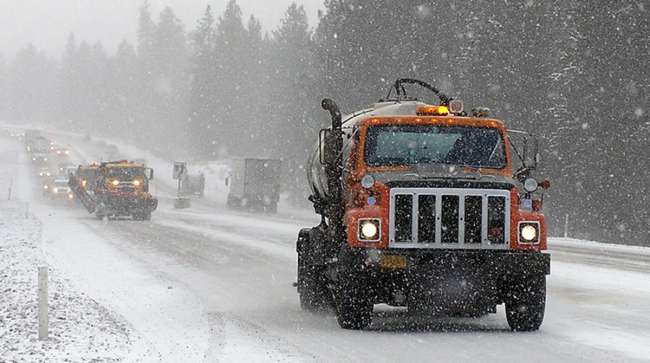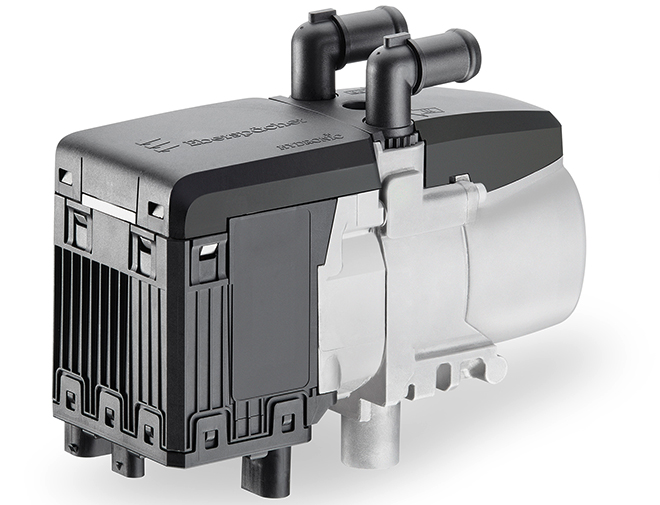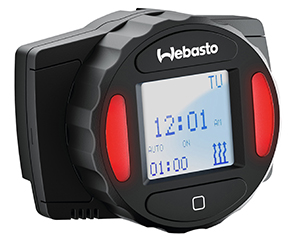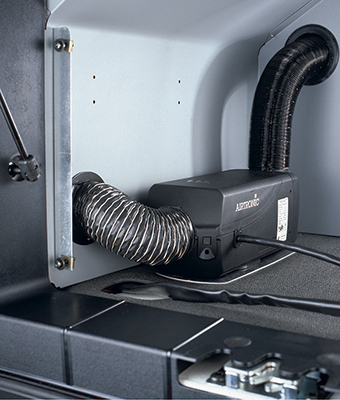Pre-Heaters Enable Reliable Engine Starts in Cold Weather

Diesel-fired engine pre-heaters can help ensure reliable engine starts in cold-weather conditions while reducing engine wear, preventing service calls and boosting driver satisfaction, fleets said.
A bonus is that these compact units run right off the truck’s batteries, eliminating the need to install the infrastructure that allows electric heaters to plug in and connect to the power grid.
Dean Foods Co. uses Eberspaecher’s coolant heaters in all its tractors in the northern half of the United States, said Marvin Psalmond, senior director of fleet operations.
The move to pre-heating began in 2010 as anti-idling regulations swept the country, at which time he instituted a three-minute idling limit.
The fleet also wanted to boost safety and keep drivers happy, Psalmond said, adding that drivers appreciate getting into vehicles that warm up and can be de-iced quickly.

Engine pre-heaters such as Eberspaecher Hydronic S3 are designed to provide reliable engine starts in cold weather. (Eberspaecher)
It’s clear to him that engine pre-heating has eliminated many service calls, because even with today’s injection systems and lower-viscosity oils, it still is hard to start a diesel in sub-zero cold.
“We used to use block heaters but found they lock you down as to where you can park the truck, and you have to get the driver to plug it in,” Psalmond said. “One location even made installing cabling and hitching posts challenging because of permitting, so they looked for another solution.”
Dean Foods, based in Dallas, ranks No. 16 on the Transport Topics Top 100 list of the largest private carriers in North America.
The less a truck idles, especially right after a cold start, the fewer the problems a fleet will experience, said John Kerwin, director of project management at Fraley & Schilling Inc.

Pre-heaters can be programmed to start automatically at a certain time on several different days. (Webasto)
The Rushville, Ind.-based carrier uses Webasto coolant heaters, which they start 60 to 90 minutes before the trucks depart, Kerwin said.
The fleet also installed bunk heaters so the sleeper alone can be heated overnight when necessary to save more fuel.
The initial goals, Kerwin said, were to reduce fuel consumption from idling the engine to heat the cab, and to get the engine warmed up more quickly because doing so greatly reduces the particulates caught in the diesel particulate filter.
Kerwin is confident this approach has generated maintenance savings related to the emission systems, including sensors. Though he can’t put a specific figure on those savings, he is certain “it’s a big number.”
With the heaters, “Drivers can get in when it’s 15 degrees out, start the engine normally and immediately defrost the windows and warm the cab,” Kerwin said. “The engine will reach operating temperature quickly, and they can get out onto the road almost right away.”
In addition, the reduced viscosity of the oil because of the warmth means better initial lubrication, which results in reduced engine wear, he said.
A positive side effect of pre-heating post-2007 diesel truck engines is improved reliability and life for the diesel particulate filters.
Duane Bratvold, western U.S. sales manager for Webasto, a maker of diesel-fired coolant and cab pre-heaters, said he has researched the effect of cold starts on DPFs. He has found that starting and running an engine in cold weather means both dirtier exhaust and a DPF that has not warmed enough to do its job. Soot accumulates instead of burning off, which quickly can lead to unit deterioration.
Laboratory testing has revealed that a cold start at 40 degrees Fahrenheit produced a 66% increase in particulate matter compared with a start at 155 degrees. Even at 75 degrees, particulate was reduced by 27% by pre-heating the engine to the same temperature.

Suppliers of coolant heaters also offer bunker heaters. Some fleets use them to heat the sleeper overnight while leaving engine pre-heating until the morning. (Eberspaecher)
Idling the engine all night for heat is wasteful, adds to operating hours and shortens the warranty period as a result, said John Dennehy, vice president of marketing and communications at Eberspaecher.
Eberspaecher’s units can be installed by ThermoKing, as well by OEM and independent dealers throughout the United States, he said.
The coolant heater is integrated into the cooling system, similar to Webasto. Although some fleets combine coolant heaters with cab air heaters, they can easily be used to heat the cab by running the heater blower, which can be automatically energized via a relay when the unit switches on.
With the right unit, a 15-liter engine can be preheated to near its operating temperature in 45 to 65 minutes, depending on the outside temperature, Dennehy said.
Engine makers also support pre-heating.
Both International Trucks, a unit of Navistar Inc., and Volvo Trucks, have standards strongly recommending or even requiring pre-heating before cranking a cold diesel in order to enhance starting and preserve the engine.
Volvo offers an air pre-heater and several other options. All Volvo trucks also have a complex cold-start regimen programmed into the engine control module.
Jim Nachtman, on-highway product manager at Navistar, said the company’s International trucks require oil pan heating at 10 degrees Fahrenheit and offer a factory-installed 300-watt pan heater. At minus 10 degrees, coolant or block heating is required. These are recommended, even though the starting of Navistar’s A26 engines was enhanced via an improved injection system and more compression in the cylinders.
Engine manufacturer Detroit, a unit of Daimler Trucks North America, recommends block or pan heaters for temperatures below minus 4 degrees Fahrenheit, said Greg Braziunas, manager of oil and coolant systems at DTNA.
Block and pan heaters can help warm up an engine prior to starting it, making it easier to start in extremely cold environments. This also preheats the engine oil and components and helps minimize potential wear.
Braziunas added that this eliminates the need for cold idling, which adds up to longer oil change intervals and reduced fuel consumption.
Several oil companies agreed that heating helps lubrication.
Heating and circulating the coolant through the engine block before starting will warm the block and the internal engine parts. This means that the engine and oil will reach operating temperature much more quickly than it would after a cold start, said Brian Humphrey, technical OEM liaison at Petro-Canada Lubricants.
“While it’s hard to quantify how advantageous engine pre-heating is, it will certainly improve overall life when operating in consistently cold climates,” he said.
Michael Wedding, manager and senior application engineer at Valvoline, said an oil’s viscosity increases almost exponentially with a temperature drop.
And Jason Head, an application engineer at Valvoline, said one of the biggest challenges is getting the oil to pump all the way from the pan at the bottom of the engine to the sensitive valve gear on top in extreme cold.
Fraley & Schilling’s Kerwin and Dean Foods’ Psalmond said that training on the heaters is essential for drivers and technicians.
Heaters should be run every time tractors come in for preventive maintenance service, in winter and summer, to purge old fuel and make sure the igniter plugs are working.
Psalmond offered a tip: When programming the timers, make sure to input the time zone where the shop is located.
Josh Lupu, Webasto’s director of marketing, said the company’s units for Class 8 trucks come with a timer that allows companies to program as many as four automatic operating periods each week. The products feature a thermostat that cycles the unit off and on in the range of 150 degrees Fahrenheit, somewhat below normal operating temperature. This is necessary to minimize fuel consumption by preventing the cooling system’s thermostat from opening and expelling heat through the radiator during pre-heating, Lupu said.
The units have a glow pin that ignites the fuel and a pump that provides atomization, but it’s essential to prevent fuel jelling in colder climates by heating the fuel tank. Service is available at some 10,000 dealers with certified technicians, and instructions are provided so fleets with large shops can install their own heaters, Lupu said.




